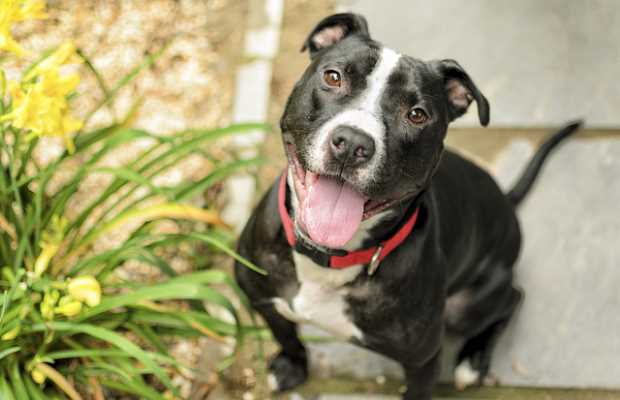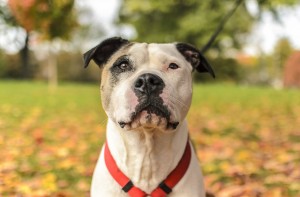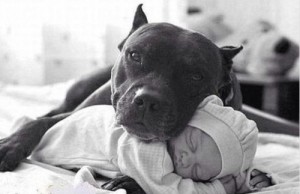
Pit bulls can be the most amazing and incredibly cuddly pets. However, a lot of people shy away from adopting a pit bull due to the bad press they get. The truth is, pit bulls are really just big babies, and if you know how to train your pitbull, their behavior will always depend on the owner. I mean, just look at this gentle 175 lbs giant!
A very important tip to begin with is if you are adopting an older pit bull (e.g. from a shelter), it is absolutely vital for you to know the history and what type of environment this dog comes from. While illegal, underground dog fighting is still taking place and you never know the type of training the previous owner used on the dog.
If you are thinking of getting a pit bull puppy, it's never a bad idea to research your pooch's breed prior to bringing in your new family member. You should be aware of any behavior traits the breed carries, how well do they do with kids, any medical concerns and personality traits.

A lot of people still don't know that “Pit bull” is a category or type of a dog. Five most common dog breeds considered to be pit bulls are:
- American Staffordshire Terrier
- Staffordshire Bull Terrier
- American Pit Bull Terrier
- Bull Terrier
- American Bulldog
The last two – Bull Terrier and American Bulldog – aren't “real” pit bulls, and are often omitted from the list of pit bull dogs. The history of these five breeds goes back into being bred for fighting, hunting and being working dogs in all sorts of areas.
Today, pit bulls are mostly loyal companions to people. Just like any other dog, they will behave nice and behave bad, depending on their training and the owner's ability to control their dogs. But public's bias towards historically aggressive nature of this dog type can oftentimes twist the reality in the press or otherwise. Nevertheless, if you decided to adopt this dog breed, here are a few tips on how to train your pitbull.
How to train your pitbull, and where to start?
Training process of training your pit bull dog usually starts the same way as with many other canines, but there are a few parts that you should extra attention to when considering how to train your pitbull and have her become an obedient, friendly dog.
Focus a lot on socialization

For those who've already adopted a pit bull recently or had one for a while and are looking for ways on how to train your pitbull dog, and have already began with the basics of training, here's another pro-tip: start socializing him early.
The sooner your dog is interacting with people and other pets, the more comfortable he will be. It’s good for them to be around a variety of different people and different situations as often as possible, as long as you know you can handle the dog.
RELATED: Important tips on how to take care of a dog
Typically, every contact is a good training opportunity to teach your pit bull how to engage with others. When having your dog interact with strangers and pets, make sure that you don’t allow any wrestling or rough play. Even though they are still puppies, this can signal aggressive behavior and it's best to eliminate any potential hostility.
Pit bulls are often somewhat lazy dogs who are also gentle. They adapt well to their surroundings and do very well in urban locations as long as they are getting plenty of exercise. They are extremely affectionate and loving. They act like big babies and always think they are your lap dog, rather than a protector on the chain. Just as any other pooch, pit bulls crave human attention.

As with any dog, always be cautious
Pit bulls are also animals, just like any other domesticated pet dog you might have chosen to adopt. Pit bulls are usually strong, which is something every pit bull owner always needs to keep in the back of their mind.
When it comes to introducing strangers to your pit bull, it’s best for it to be on the dog’s terms. If a stranger (to the dog) is welcomed into your home and your pit bull doesn't know the person, have that person ignore your pet. They should not make eye contact, try to approach or touch the dog in any way. Once your dog feels more secure, he will approach the person, sniffing and exploring, if you let them. Only then the stranger can touch, pet and acknowledge the dog.
Outside of these two important observations – most of which is attributed to pit bulls strength rather than anything else – if you want to know how to train your pitbull, simply abide the standard dog training procedure.
Emphasize “gentle” training of your pit bull

Number one in training a pit bull is positive reinforcement – it's always the best way to go. Your pit bull is a very eager learner and happy to please you. Using treats and lots of praise is a great way to enforce the training.
Teaching your young pit bull to let go of puppy toys without showing aggression is important. Using toys such as tug rope can teach them how to play nicely and how to let go respectfully. Never try to pull a toy from your puppy’s mouth. Instead, try teaching him commands like “let go” or “trade” in getting him to release the toy for a treat is a great way to teach a young pit bull to be gentle.
Unfortunately, pit bulls have been bred to be fighting dogs, so they may not be so tolerant of other dogs regardless of training. With that being said, every pit bull dog will have their own personality.
Introducing your pit bull to other dogs

Some pit bulls do very well in a household among other animals, while others just don’t like being around other dogs. It's a common breed trait of pit bulls, but do not take this as a sign that your pit bull will not be good around people.
The hardest part when owning a pit bull will be having them love every other dog in the neighborhood, but this is the price you have to pay. When meeting another dog with your pit, always stay close by, keeping your dog on a leash as he gets comfortable around the other animals that are strangers to him. Never presume that your dog will be friendly, even if 99% of the time he usually is.
RELATED: Best books every dog owner needs to read
Even if your dog does show aggression towards other canines, it is absolutely your responsibility to teach them how to behave in those situations. The truth is, pit bulls can be aggressive, but owners can and must teach them not to be (or rather sustain their aggression).
When learning how to train your pitbull, start by practicing the most important commands like “sit” and “stay;” this will help to keep your pet from getting too agitated.
Some certified dog trainers suggest that by having your pit bull focus on you instead of the other dog you can help reduce distractions and calm them down. Giving your pooch a treat when they notice another dog or animal but leaves it alone and focuses on you will reinforce that behavior.
How to train your pitbull with professionals

If after going through training your Fido continues to show hostility, it may be necessary to enroll her into an obedience training school with a professional trainer to help eliminate that behavior. They will get plenty of exercise and straight-to-the-point training.
This breed requires at least two hours of exercise a day. Keeping them active will help in curbing some aggression, which is why any type of class is great in addition to whatever you two do together at home. Taking your pit bull on long on walks or jogs helps in training them to behave on a leash and with distractions.
RELATED: Best dog treadmills for exercising your pet at home
Having your pit bull also go through agility training can be very beneficial in training them. As a breed, pit bulls are extremely agile and with their strong determination, they will thrive in that type of training. This will also help in curbing aggression, reducing hyperactivity and challenge your dog's mind. Dog sports in general is yet another great option to showcase your Fido's talent and where pit bulls can excel.
Pro-tip: Similarly to how you would treat any other dog, during the period of training your pit (and whenever possible), always observe your dog’s body language. If your pit bull is pacing, growling or appears to be agitated, it’s best to assess the situation quickly and see what you can do to change it. If this attitude doesn't go away, it must be addressed with a professional.
A few more tips on training your pit bull

Pit bulls thrive when having a private place to go when they get overwhelmed. Using dog crates or providing your pooch with his own bed or dog house is a great way to give them that opportunity, but never use the dog crate as punishment. A crate is always your dog's home.
As with any dog, be respectful of other pet owners and dogs when out and about. There is a stigma that comes with the pit bull breed, and you may encounter criticism for owning a pit bull. If someone is nervous around your pet, keep your pooch on a leash and watch them closely. Even though your pup may be the sweetest one there, a pit bull will always be the one that gets the blame if anything happens.
In the end, if you break it down, pit bulls are truly excellent companions. They are very loyal and loving to their family. When thinking of adopting a pit bull, it’s important to take into account this breed's requirements, pros and cons; you'll have to provide them with a structured, stable environment. If you give your pit bull plenty of attention, affection, exercise, positive training and have an understanding of your dog’s feelings, your pooch will be a wonderful addition to your family.
To wrap things up, let me leave you with this great pit bull training video:












